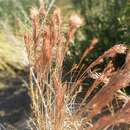ar
الأسماء في صفحات التنقل


The Andropogoneae, sometimes called the sorghum tribe, are a large tribe of grasses (family Poaceae) with roughly 1,200 species in 90 genera, mainly distributed in tropical and subtropical areas. They include such important crops as maize (corn), sugarcane, and sorghum.[2] All species in this tribe use C4 carbon fixation, which makes them competitive under warm, high-light conditions.[3]
Andropogoneae is classified in supertribe Andropogonodae together with its sister group Arundinelleae. Subdivisions include 12 subtribes, but the position of several genera within them is still unresolved (incertae sedis). Hybridisation was probably important in the evolution of the Andropogoneae, and the tribe's systematics is still not completely resolved.[3]
Spikelets within the inflorescence (flower cluster) are generally arranged on spicate racemes in pairs. A fertile, unstalked spikelet is subtended by a sterile, stalked spikelet. In species where awns are present they are found on the fertile, unstalked spikelet as an extension of the lemma.[4]
Classification following Soreng et al. (2017).[1]
The Andropogoneae, sometimes called the sorghum tribe, are a large tribe of grasses (family Poaceae) with roughly 1,200 species in 90 genera, mainly distributed in tropical and subtropical areas. They include such important crops as maize (corn), sugarcane, and sorghum. All species in this tribe use C4 carbon fixation, which makes them competitive under warm, high-light conditions.
Andropogoneae is classified in supertribe Andropogonodae together with its sister group Arundinelleae. Subdivisions include 12 subtribes, but the position of several genera within them is still unresolved (incertae sedis). Hybridisation was probably important in the evolution of the Andropogoneae, and the tribe's systematics is still not completely resolved.
Andropogoneae es una tribu de hierbas de la familia Poaceae extendida por todas las regiones tropicales y templadas. Estas plantas utilizan la vía de 4 carbonos para realizar la fijación del carbono por fotosíntesis.
Son hierbas anuales o perennes con hojas delgadas longitudinales, raramente lanceaoladas. Las inflorescencias forman panículos terminales compuestos sostenidos por espatas, los racimos están formados por dos espiguillas florales, una sésil (fértil) y la otra pediculada (estéril).
Andropogoneae es una tribu de hierbas de la familia Poaceae extendida por todas las regiones tropicales y templadas. Estas plantas utilizan la vía de 4 carbonos para realizar la fijación del carbono por fotosíntesis.
Son hierbas anuales o perennes con hojas delgadas longitudinales, raramente lanceaoladas. Las inflorescencias forman panículos terminales compuestos sostenidos por espatas, los racimos están formados por dos espiguillas florales, una sésil (fértil) y la otra pediculada (estéril).